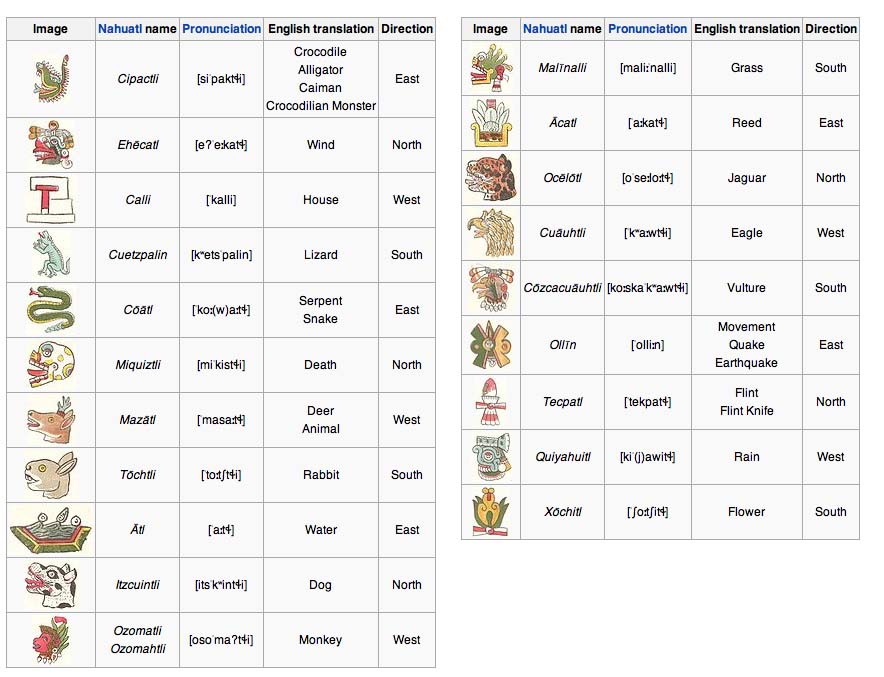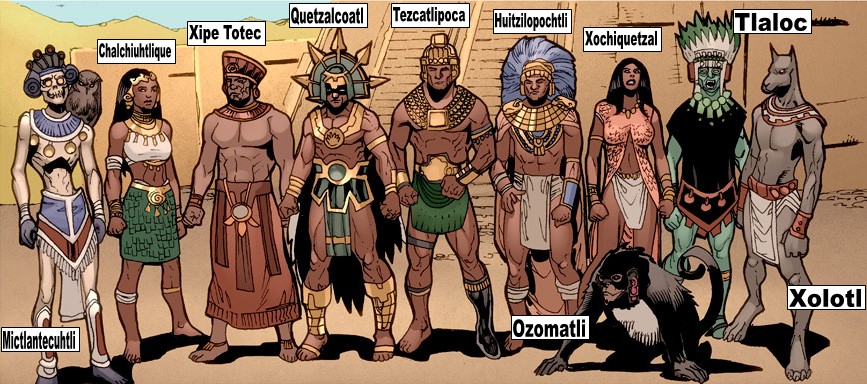Aztec Calendar

Friday, April 17, 2015
Aztec Clothing
Along with every culture comes the way they dress. The Aztecs were no different. They dressed very casually and received a culture shock when the Spanish invaded due to their full armor. The Aztecs typically wore loose clothing, and while it was not considered skimpy, it did not fully cover everything. Their clothes and tunics were usually made of cotton and dyed with an array of colors. If they were in the military, their "costume" was usually embroidered with a eagle or a jaguar to show power and superiority. The common people dressed very differently. Slaves simply wore a loincloth, women wore skirts and sleeveless blouses with mild designs, and men often donned a cloak of sorts called tilmas, which was fashioned from a triangular cloth.

Aztec Quiz
1. What did boys do during their daily life?
2. Who did the Aztecs worship?
3. What God were the round pyramids built for?
4. What important instruments did the Aztecs use?
5. Art was an important part of Aztec culture. True or False
6. What number system was the Aztec number system based on?
7. Many believe the Aztecs to originally be hunter-gatherers. True or False
8. What language did the Aztecs originally speak?
9. What role did girls play for each household?
10. What is a festival that occurs 3 times a year to encourage rain fall?
11. How many days did the Xiuhpohualli have?
What happened to the Aztecs?
2. Who did the Aztecs worship?
3. What God were the round pyramids built for?
4. What important instruments did the Aztecs use?
5. Art was an important part of Aztec culture. True or False
6. What number system was the Aztec number system based on?
7. Many believe the Aztecs to originally be hunter-gatherers. True or False
8. What language did the Aztecs originally speak?
9. What role did girls play for each household?
10. What is a festival that occurs 3 times a year to encourage rain fall?
11. How many days did the Xiuhpohualli have?
What happened to the Aztecs?
Thursday, April 16, 2015
Aztec Capital
Tenochtitlan became the capital of the expanding Mexican Empire. At its peak ,the city was the largest city in the Pre-Columbian Americas. Tenochtitlan was founded where an eagle was eating a snake, sitting on a cactus in the middle of a lake. Tenochtitlan was formed on top of this lake, despite the unfavorable terrain. Mexico City was then built on top of Tenochtitlan as shown below.

Tenochtitlan's main temple complex, the Templo Mayor, was dismantled and the central district of the Spanish colonial city was constructed on top of it. The great temple was destroyed by the Spanish during the construction of a cathedral. The location of the Templo Mayor was rediscovered in the early 20th century, but major excavations did not take place until 1978–1982. The ruins of Tenochtitlan still remain under Mexico city.

Tenochtitlan's main temple complex, the Templo Mayor, was dismantled and the central district of the Spanish colonial city was constructed on top of it. The great temple was destroyed by the Spanish during the construction of a cathedral. The location of the Templo Mayor was rediscovered in the early 20th century, but major excavations did not take place until 1978–1982. The ruins of Tenochtitlan still remain under Mexico city.
Aztec Music
Music was an important part of life for many aztecs. Music was used as a way of passing down tradition. In school, music was an important subject. Significant cultural songs were taught to students between the ages of 12 and 15. They would sing hymns in bands. These hymns would be to the gods, telling about what they had done. Along with these they sang lighthearted songs about everyday life. The symbolism in their songs is so bizarre to us today it can be very hard to get any real meaning.
The use of drums played a big part in Aztec music. These drums were accompanied by music or played alone. Some of their drums were the aoytl, teponaztli, and huehuetl.
The use of drums played a big part in Aztec music. These drums were accompanied by music or played alone. Some of their drums were the aoytl, teponaztli, and huehuetl.
Wednesday, April 15, 2015
Aztec Festivals
The Aztecs have many celebrations and festivals. One festival is called the Aztec Rain Festival Celebration. It is celebrated 3 times a year to encourage rain-fall. The first rain festival at the beginning of the agricultural year in February. The second rain festival was offered to Tlaloc and other rain gods in March, once flowers had begun to bloom. The Aztecs formed images of the god, Tlaloc, in small mountains. Another festival is the Celebration of Quecholli Festival. It is a celebration to honor Mixcoatl, who is also known as the Cloud Serpent. He is one of four creators of the world; they believed he created the humans. The Aztecs honor him by a ceremonial hunt.
Aztec Language
Aztecs communicated with each other through a language called Nahuatl as well as they a system of hieroglyphs. This form of writing was poorly understood early on in the development of the Aztec empire. It had three primary functions: to mark calendrical dates, to record accounting mathematical calculations, and to write names of people and places.

Tuesday, April 14, 2015
Aztec Pyramids
Aztec people valued their craftsmanship. They were known to build pyramids similar to those of the Mayas. They also created some of their own called the twin stair pyramids, such as the one in the Temple Mayor of Tenochtitlan. In these pyramids their were two towers and a double staircase. Each god had their own if these temples.
Round pyramids were another type of pyramids they built. This type of pyramid was built in honor of the wind god Quetzalcoatl. The pyramids were built in a round shape. This was so that it would not be a barrier for the wind. These were popular in Taluco Valley.
Round pyramids were another type of pyramids they built. This type of pyramid was built in honor of the wind god Quetzalcoatl. The pyramids were built in a round shape. This was so that it would not be a barrier for the wind. These were popular in Taluco Valley.
Aztec Lifestyle
The Aztec people lived in a way very different from the way we live today. It was a fairly simple daily routine, consisting of the same schedule everyday. Men would farm or engage in craftwork, while women, for the most part, cooked and wove. At home, the family was made of a married couple, the father and husband, and all of their unmarried children, as well as some of the father's relatives. Ever single person had a set of chores to do, such and managing goods to trade in the empire, such as jaguar skins, which were highly valued in the Aztec culture. Boys generally went to temple where the learned more about religion and received military training. Girls, on the other hand, stayed at home and helped their mothers.

Monday, April 13, 2015
Aztec Numbering System
The Aztecs used a numbering system that is similar to roman numerals. It uses symbols for 1, 5, 10, 20, 100, 400 and 8000.
Aztec Religion
Aztecs valued their religion as an extremely significant part of their culture. They were not a monotheistic culture, and they worshiped many gods and goddesses who controlled each a different aspect of their everyday life. As a huge part of their life was based on agriculture, many of their deities controlled farming. Aside from that, they had a lot of natural element and ancient hero based gods and goddesses. Some of their gods include: Mictlantecuhtli, Chalchiuhtlique, Xipe Totec, Quetzalcoatl, Tezcatlipoca, Huitzilopochtli, Xochiquetzal, Ozomatil, Tlaloc, and Xolotl.
Aztec People
⠀ ⠀ The Aztecs, who were people that lived before pre-Columbian times, lived in the 15th and 16th century. These people spoke Nahuatl. They ruled a large empire in what is now central and southern Mexico. They were also called Aztlán and Tenochca. But the Aztecs referred to themselves as Culhua-Mexica. The Aztecs' origin are uncertain but, many believe they were hunter-gatherers based on their traditions. In 1325, they found Tenochtitlán. Tenochtitlán became and remained their chief centre. Under the rule of Itzcóatl in 1428-40, Tenochtitlán formed alliances with Texcoco and Tlacopan and became the dominant power in central Mexico. Their empire kept expanding for 200 years. In 1502-20, Montezuma II , or Moctezuma II, ruled the empire. A year later, Hernán Cortés captured Montezuma II and kept him prisoner. After that, the empire fell apart.
Friday, April 10, 2015
Aztec Art
Aztec art played a big part in Aztec culture. Artists made everything from intricate masks to delicate pottery. Masks were used to be presented as tributes to the gods whom the Aztec people worshipped. Designed with color were created by skilled craftsmen to be used in rituals and ceremonies, made to honor and worship divine beings. Aztec Indians also went through a series of steps to mold and create pottery, made by layering strips if clay over and over again. At the end of the cycle, the strips were shaped into objects such as griddles, storage devices, goblets, and other vessels, as well as decorative statues. After it had hardened, designs and geometric patterns were painted on.

Aztecs Calendar
One Aztec calendar is called the Xiuhpohualli, has 365 days. It shows days and rituals throughout their solar year. It had a similar format to the calendars of nearby cultures. The calendar was dedicated to the sun gods called Tezcatlipoca, Quetzalcoatl, Tlaloc and Chalchiuhtlicue. The Aztec calendar is similar to the Mayan calendar; however, it is more ambiguous because the people would take note of the day as it passed. The day-signs are shown below; each one represents a cardinal direction and a symbol.


Subscribe to:
Posts (Atom)



